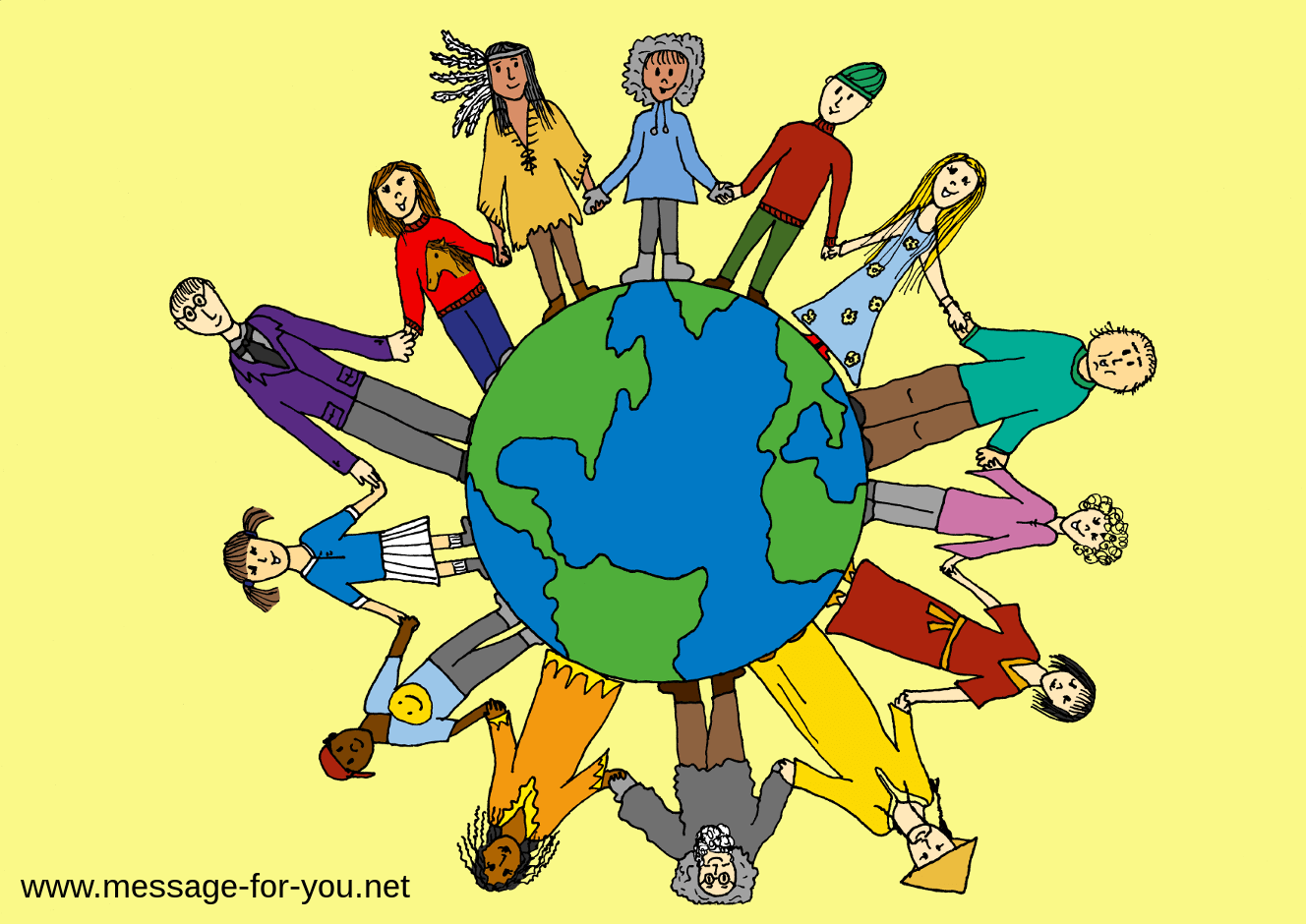Message For You! The World’s Best Message In Your Own Language
The following message has changed the lives of billions* of people. Why not yours also? Please take the time to watch it. It is well worth it… (Short Version only approx 10 minutes)
Zur Botschaft (auf Deutsch/German)
More languages: see Languages Overview below:
*Since the beginning of the original message 2,000 years ago, see message.
The message is available in different languages.
You can choose your language in the list below.
Available languages (total): 108
New languages are added from time to time!
Latest added: Welsh
Red = 2 (finished/revised translations)
Orange = 106 (temporary rough translations, but already published and meant for sharing, see article Explanation on the Temporary Rough Translations)
Grey = ca. 40 (languages that are not yet published as translations. More coming soon, to be continued. Not counted in the “total”)
Dialects = coming soon (not counted in the “total”)
Fantasy languages and secret languages = coming soon (not counted in the “total”)
How the languages are counted and what kinds of versions of languages there are (click to open)
How the languages are counted and which versions of the languages there are
Here you will find a short explanation of how we count the languages and which versions of the languages there are.
We count most languages and then enter the total number above at “Available languages (total)”.
Not counting towards “total”:
Dialects (which are usually not considered as an individual language), fantasy languages (languages constructed by humans, e.g. Elvish), secret languages (languages also constructed by humans, e.g. Emoji), grey languages, language main subpages (e.g. “German Languages (Overview)”), informal and formal versions (e.g. “Du-Form” and “Sie-Form”), children’s versions, versions of written script (e.g. Cyrillic script and Latin script of the same language), other versions (e.g. language variations in different countries, but of the same language such as “Spanish – Spain” and “Spanish – USA”), multiple names of the languages (shown in brackets after each language) and references of the languages (e.g. “see”, “not to be confused with”, “similar to” etc. in the languages overview below), are available in the languages overview, but will not be counted towards the total under “Available languages (total)”.
Exceptions that are counted under “total”:
Planned languages (constructed languages that were developed by people for specific purposes, e.g. as international communication, e.g. Esperanto), endangered languages (that have few speakers and are therefore in danger of dying out), extinct languages (that no one speaks anymore), dead languages (that no one speaks as their native language anymore, but that is still taught as a language but is not developing further), liturgical languages or sacred languages (e.g. languages used in a liturgical celebration by different religions, e.g. Latin, Sanskrit) and all other languages (which are not excluded above under “Not counted”) will count towards the total number of all languages.
Note on correctness of the versions and names of the languages etc.:
We strive to ensure accuracy of the versions and names of the languages etc., but cannot rule out the possibility of errors. Some of the errors, such as colloquial names of the languages, are intentional in order to reach more people who search for the search term. We developed the Languages Overview through our own internet research, but we have not studied linguistics. But that is not what it is about, it is about spreading the message. More about this and further explanations can be found under Explanation on the Languages Overview
You can find all languages in the overview below (scroll down).
Tip: If you can not find your desired language (click to open)
If you can not find your language immediately in the overview below, use your browser’s search function:
On your PC: Then you can press the keys Ctrl and F both (by continuing to hold) on your PC. Then you can see a search box. Type in your language (in your mother tongue) in that search box and click Enter. If you then see more search results, then use the symbols ˄ and ˅ to show every single search result.
On your mobile device: Or if you are on a mobile device (for example using your smartphone): Then type on the three dots right above the browser (menu symbol). Then type on “Find in page”. Then you can type in your language in the search box and type on Enter or on the lens symbol. If you then see more search results, then use the symbols ˄ and ˅ to show every single search result.
For other devices, please search the Internet for other instructions.
Further questions and answers and explanations on the translations:
You can find further questions and answers and explanations on the translations on the subpage Explanation on the Languages Overview
Below the Language Overview you can find even more explanation on the translations.
The languages are in alphabetical order (A-Z) according to the ENGLISH names of the languages. But you can also find the names in mother tongue in the bracket behind each language.
Click on the desired language:
Aa Bb Cc Dd Ee Ff Gg Hh Ii Jj Kk Ll Mm Nn Oo Pp Qq Rr Ss Tt Uu Vv Ww Xx Yy Zz
Abaza (абаза бызшва, abaza byzšwa, абазэбзэ)
Acehnese (Achinese, Bahsa/Basa Acèh, بهسا اچيه)
Achinese – see “Acehnese”
Adyghe (West Circassian, Cherkess, КӀахыбзэ, K’axybzæ, Адыгабзэ, Adygabzæ)
Afghan Persian – see “Persian – Afghan Persian (Dari)” or “Persian”; Not to be confused with “Afghani”
Afghani (افغانی , Afghāni) – see “Pashto”; Not to be confused with “Afghan Persian”
Afrikaans (Afrikaans, Cape Dutch)
Albanian (shqip, gjuha shqipe, Shqiptar, Shqiptare)
Amharic (አማርኛ, amarəñña)
Arabic (Arabian language, اللغة العربية , اَلْعَرَبِيَّةُ , al-ʿarabiyya, عَرَبِيّ, ʿarabīy)
Aramaic/Aramaean (Aramaian, ארמית , Arāmît, ܐܪܡܝܐ , Ārāmāyâ, Turoyo, Ṭūroyo, Ṭūr ‘Abdinian Aramaic, Surayt, Sūrayṯ, Suryoyo, Sūryōyō, ܛܘܪܝܐ , Syriac, Syrian; Not to be confused with “Armenic” – see “Armenian”)
Armenian/Armenic (հայերէն/հայերեն, Hayeren, Hayaren, Haieren; Not to be confused with “Aramaic”)
Assamese (অসমীয়া, asamīẏā)
Austro German – see “German – Austro German”
Azerbaijani (Azərbaycan, Azeri, آذربایجان دیلی , Азәрбајҹан дили)
B
Bai (Bairt‧ngvr‧zix, Báiyǔ, 白語, 白语)
Bangla/Bangladesh language – see “Bengali”
Bashkir (Башҡортса Bashqortsa, Башҡорт теле Bashqort tele, Basquir; Not to be confused with “Basque”)
Basque (Euskara; Not to be confused with “Basquir” – see “Bashkir”)
Basquir – see “Bashkir” (Not to be confused with “Basque”)
Belarusian(Belarusan, Belarussian, Belorussian, беларуская мова belaruskaja mowa)
Bengali (বাংলা ভাষা, bāṃlā bhāṣā, Bangla, Bangladesh language)
Binisaya – see “Bisaya”
Birmese – see “Burmese”
Bisaya/Bisayan – see “Cebuano”
Bosnian (bosanski jezik/босански језик)
Bulgarian (български език, bălgarski esik)
Burman – see “Burmese”
Burmese (bəma˨sa˨, မြန်မာစာ, mranmabhasa, Myanmar language, Burma language, Burman language)
C
Canadian French – see “French – Canada/Canadian French” (Not to be confused with “Kannada”)
Cambodian – see “Khmer”
Cape Dutch – see “Afrikaans”
Castilian/Castillian/Castellano – see “Spanish”
Catalan (Valencian, valencià, catalá)
Cebuan/Cebuano (Binisaya, Bisaya, Bisayan, Visayan, Sebwano, Cebuan from Cebu island on the Philippines)
Changana – see “Xitsonga”
Chewa – see “Nyanja”
Chichangana – see “Xitsonga”
Chichewa – see “Nyanja”
Chishangana – see “Xitsonga”
Chishona – see “Shona”
Chitsonga – see “Xitsonga”
Chinyanja – see “Nyanja”
Chinese
Circassian – see “Adyghe”
Cherkess – see “Adyghe”
Chuukese (Chuuk, Ruk, Trukese)
Corsican (Corsu, Lingua Corsa)
Cree (Nēhiyawēwin, ᓀᐦᐃᔭᐍᐏᐣ)
Creole – see “Haitian Creole” and “Mauritian Creole”
Croatian (hrvatski jezik)
Cymric – see “Welsh”
Czech (český jazyk, čeština)
D
Danish (dansk)
Dari in Afghanistan ( دری , Darī, فارسی دری , Fārsī-yi Darī) – see “Persian – Afghan Persian (Dari)” or “Persian”; Not to be confused with the other “Dari” – see “Dari in Iran”
Dari in Iran (Gabri , دری ; Not to be confused with the other “Dari” – see “Dari in Afghanistan”)
Duala (Duálá)
Dutch
Dutch – Cape Dutch – see “Afrikaans”
Dutch people in Friesland of the Netherlands – see “Frisian” – “West Frisian”
E
English (All Versions)
Esperanto (Constructed/Plan language Esperanto; Not to be confused with “Español” – see “Spanish”)
Estonian (eesti keel)
Euskara – see “Basque”
F
Faroese (føroyskt mál)
Farsi (Fārsī, форсӣ, Iranian Persian ,زبان فارسی , similar to Dari – see “Dari in Afghanistan”)
Fijian (Fiji, Na vosa vaka-Viti)
Filipino/Philipino (Wikang Filipino, Pilipino, Tagalog)
Finnish (suomi, suomen kieli)
Frisian
Frisian in Northern Germany – North Frisian (nordfriisk; Not to be confused with Frisian in Friesland in the Netherlands – see “West Frisian”)
Gabri – see “Dari in Iran”
Gaelic – see “Irish” and “Scottish Gaelic”
Galician (Galego, Gallego)
Gallego/Galego – see “Galician”
Ganda – see “Luganda”
Georgian (ქართული ენა, kartuli ena)
German Languages (Overview)
German/Deutsch 2
(Formal Form/Sie-Form)
German/Deutsch (Children’s Version/ Kinderversion)
German – Austro German (Austrian German, Österreichisch)
German – Judeo-German – see
“Yiddish”
German – Low German (German mostly in some parts of North Germany, Plattdeutsch, Holsteiner Platt, Niederdeutsch)
German – Swiss German (German in Switzerland, Schwizerdütsch, Schwiizertüütsch, Schweizerdeutsch)
Greek (ελληνική, ellinikí)
Gujarati (Gujarathi, ગુજરાતી, Gujarātī)
Gurkha/Gurkhali – see “Nepali”
H
Haieren – see “Armenian”
Haitian Creole (kreyòl ayisyen, Creole, Kreyòl)
Harshen/Halshen Hausa – see “Hausa”
Hausa (Harshen/Halshen Hausa, Hausanci, هَرْشَن , هَوْسَ)
Hawaiian (ʻŌlelo Hawaiʻi)
Hayeren/Hayaren – see “Armenian”
Hebrew (Ivrit, עברית , ‘Ivrit)
Hiligaynon (Ilonggo)
Hindi (हिन्दी, हिंदी, Hindī)
Hmong/Mong (Hmoob)
Hmoob – see “Hmong”
Hungarian (Magyar nyelv)
I
Ibo – see “Igbo”
Icelandic (íslenska)
Igbo (Ibo, Ásụ̀sụ́ Ìgbò)
Ikinyarwanda – see “Kinyarwanda”
Indonesian (Bahasa Indonesia)
Inuinnaqtun – see “Inuktitut”
Inuit language – see “Inuktitut”
Inuktitut (Language of the Inuits/Eskimo, Inuinnaqtun, ᐃᓄᐃᓐᓇᖅᑐᓐ)
Iranian Persian – see “Persian (Farsi)”
Irish (Gaeilge, Gaolainn, Gaelic; Not to be confused with “Scottish Gaelic”)
Isan – see “Lao”
Italian (Italiano)
Ivrit – see “Hebrew”
J
Japanese (日本語, にほんご, ニホンゴ, nihongo, Not to be confused with “Javanese”)
Javanese (basa Jawa, ꦧꦱꦗꦮ, باسا جاوا , Not to be confused with “Japanese”)
Jingpho/Jingpo – see “Kachin”
Judeo-German – see “Yiddish”
K
Kachin (Jingpho, Jingpo language)
Kannada (ಕನ್ನಡ, Not to be confused with “Canada” – see “Canadian French”)
Kazakh/Qazaq (qazaqşa)
Kechua – see “Quechua”
Khalkha – see “Mongolian”
Khmer (Cambodian, ភាសាខ្មែរ, Phéasa Khmér)
Kichwa – see “Quechua”
Kinyarwanda (Ikinyarwanda, Rwandan, Ruanda)
Kirghiz/Kirgiz – see “Kyrgyz”
Kiswahili – see “Suaheli”
Korean (hangugeo, hangugmal, 한국말, chosŏnmal, 조선말)
Kurdish – Kurmanji (Kurdî, Kurmancî, Kurmanci, کوردی)
Kurmanji – see “Kurdish”
Kyrgyz (Kirgiz, Kirghiz, Кыргыз, Kyrgyz tili, قیرغیزچا )
L
Lao/Laotian ( ລາວ, ພາສາລາວ, Phasa Lao; similar to Northeastern Thai, Thai Isan, Lao Isan; Not to be confused with “Luo”)
Lappish – see “Sami”
Latin (Latīnum, Lingua Latīna)
Latvian/Lettish (latviešu valoda, Latviski)
Lettish – see “Latvian”
Lingala (Ngála)
Lithuanian (lietuvių kalba)
Low German– see “German – Low German”
Luganda (Ganda, Oluganda)
Luo (Dholuo, d̪ólúô; Not to be confused with “Lao”)
Lushai/Mizo
Luxembourgish/Luxemburgish (Lëtzebuergesch, Luxembourgian, Luxemburgisch)
M
Maasai (ɔl Maa)
Macedonian (македонски јазик, makedonski jazik)
Magyar – see “Hungarian”
Malagasy (malagasy,language of Madagascar)
Malay/Malayic (Bahasa Melayu , بهاسا ملايو ) – see “Malaysian” or “Indonesian”
Malayalam (മലയാളം, Malayāḷaṁ;Not to be confused with “Malaysian”)
Malaysian (Malaysian Malay, Bahasa Malaysia, Bahasa Melayu Malaysia , بهاس مليسيا; Not to be confused with “Malayalam”)
Maltese (Malti)
Mandarin – see “Chinese”
Manipuri (ইমার ঠার/বিষ্ণুপ্রিয়া মণিপুরী, imār ṭhār, biṣṇupriẏā maṇipurī, Meitei)
Maori (Te Reo Māori)
Marathi (मराठी, Marāṭhī)
Mauritian Creole (Morisien, Morisyen, kreol morisien)
Meitei – see “Manipuri”
Miskito (Miskitu)
Mizo – see “Lushai”
Moldavian – see “Moldovan”
Moldovan (Moldavian, limba moldovenească, лимба молдовеняскэ, лимба молдовенѣскъ) – see “Romanian”
Mong – see “Hmong” (Not to be confused with “Mongolian”)
Mongolian (Mongol, монгол хэл, ᠮᠣᠨᠭᠭᠣᠯ, ᠬᠡᠯᠡ, Khalkha; Not to be confused with “Mong” – see “Hmong”)
Morisien/Morisyen – see “Mauritian Creole”
Myanmar language – see “Burmese”
Nauruan (Nauru, dorerin Naoero)
Nepali (Nepalese language, नेपाली, Nepālī, Gorkha, Gorkhali, Gurkha, Gurkhali)
Netherlandic – see “Dutch”
Norwegian (Norsk)
Nosu – see “Yi”
Nuosu – see “Yi”
Nyanja (ChiNyanja, ChiChewa, Chewa)
O
Odia (Odiya, ଓଡ଼ିଆ, Oṛiā, Oria, Oriya)
Odiya – see “Odia”
Oria – see “Odia”
Oriya – see “Odia”
Ozbek/Oʻzbekcha – see “Uzbek”
P
Panjabi – see “Punjabi”
Papiamentu (Papiamento)
Pashto (Pakhto, Pashtu, Pushto, پښتو, Pəx̌tó, Pax̌tó)
Persian
Persian – Afghan Persian (Dari)
Persian – Tajik Persian (Tajik)
Pilipino – see “Filipino”
Polish (język polski, polszczyzna)
Portuguese (Português)
Punjabi/Panjabi (پنجابی , پن٘جابی , ਪੰਜਾਬੀ , Panjābī, Gurmukhī, Gurmukhi, ਗੁਰਮੁਖੀ)
Q
Qazaq/Quazaq – see “Kazakh”
Quebec/Québec – see “Canadian French”
Quechua (Runa Simi, Runasimi, Qhichwa Simi, Qheswa Simi, Kichwa, Kechua, Kechuan, Quechuan, Quichua)
Quichua – see “Quechua”
R
Romanian/Rumanian (limba română, românește, similar to “Moldovan/Moldavian”)
Ruanda – see “Kinyarwanda”
Ruk – see “Chuukese”
Rumanian – see “Romanian”
Runasimi – see “Quechua”
Russian
Rwanda/Rwandan – see “Kinyarwanda”
S
Sami/Lappish (Sámegiella)
Samoan (Gagana Sāmoa, Gagana faʻa Sāmoa)
Scots Gaelic – see “Scottish Gaelic”
Scottish Gaelic (Scots Gaelic, Gàidhlig, Gaelic, Not to be confused with “Irish”)
Sebwano – see “Cebuano”
Serbian (српски језик, srpski jezik)
Sesotho (Sotho, language of the Basotho in Lesotho)
Shangaan – see “Xitsonga”
Shangana/Shangani – see “Xitsonga”
Shona (chiShona)
Shqiptare – see “Albanian”
Siamese – see “Thai”
Sindhi (सिंधी , سنڌي , Sindhī)
Sinhalese (සිංහල, Sinhala)
Slovak (slovenčina)
Slovenian (Slovene, slovenščina)
Somali (Af-Soomaali, Af Soomaali, Soomaali, اف صومالي , صومالي)
Sotho – see “Sesotho”
Spanish
Spanish – Standard Spanish/Spain (Espanol, Español, Castellano, Castilian, Castillian)
Spanish – USA/Southern America (Hispanic, Hispano, Hispanol)
Suaheli/Suahili/Swahili (Kiswahili, كِيْسَوَاحِيْلِيْ )
Sundanese (Basa Sunda)
Surayt/Suryoyo – see “Aramaic”
Swahili – see “Suaheli”
Swedish (Svenska)
Swiss German – see “German – Swiss German”
Syriac/Syrian – see “Aramaic”
T
Tadzikh – see “Tajik”
Tagalog – see “Filipino”
Tajik (Tadzikh, Забони тоҷикӣ, Zaboni Tojikī, Tajik Persian, Tajiki, форси́и тоҷикӣ́, forsii tojikī) – see “Persian – Tajik Persian”
Tamil (தமிழ், Tamiḻ)
Tartar – see “Tatar”
Tatar (Tatarian, Tartar, Tartarian, татар теле, tatar tele, татарча, tatarça)
Telugu (తెలుగు)
Te Reo Māori – see “Maori”
Thai
Thai – Isan/Northeastern Thai (ภาษาอีสาน, ภาษาไทยถิ่นตะวันออกเฉียงเหนือ, ภาษาไทยถิ่นอีสาน, ภาษาไทยอีสาน, ภาษาลาวอีสาน, Northeastern Thai, Thai Isan, Lao Isan, Lao) – see “Lao”
Tonga/Tongan (Tonga, lea fakatonga. Not to be confused with “Tsonga” – see “Xitsonga”.)
Trukese – see “Chuukese”
Tsonga – see “Xitsonga” (Not to be confused with “Tonga/Tongan”)
Tswa-Ronga – see “Xitsonga”
Turkish (Türkçe, Türkiye Türkçesi; Not to be confused with “Turkmen”)
Turkmen (türkmençe, түркменче , تۆرکمنچه , Not to be confused with“Turkish”)
Turoyo – see “Aramaic”
U
Uighur – see “Uyghur”
Ukrainian (українська мова, ukrainska mova)
Urdu (اردو, اُردُو , Urdū)
Uyghur (Uighur, ئۇيغۇرچە , Уйғурчә, Uyghurche, Uyƣurqə, Uyğurçä)
Uzbek (Oʻzbekcha, Ozbek, Özbek, ўзбекча , اۉزبېکچه)
V
Valencian – see “Catalan”
Vietnamese (tiếng Việt, Hán Nôm, 㗂越, tiếng Việt Nam, 㗂越南, Việt ngữ, 越語)
Visayan – see “Cebuano”
W
Welsh (Cymric, Cymraeg, y Gymraeg)
White Russian – see “Belarusian”
X
Xangana – see “Xitsonga”
Xhosa (isiXhosa)
Xichangana – see “Xitsonga”
Xitsonga (Language of the Tsonga/Shangaan people, Tswa-Ronga, Shangaan, Shangani, Shangana, Changana, Chishangana, Chishangana, Chitsonga, Xichangana, Xangana, Thonga. Not to be confused with “Tonga”.)
Y
Yi (Nosu, Nuosu, 彝语, Yíyǔ, ꆇꉙ)
Yiddish (ייִדיש , יידיש , אידיש , yidish, idish, “Jewish”, Yiddish-Taitsh, Judaeo German, Judeo German, jiddisch-daitsch, jüdisch-deutsch)
Yoruba (èdè Yorùbá, عِدعِ يوْرُبا)
Z
Zulu (isiZulu)
![]()
You can find questions and answers and explanations on the translations on the subpage Explanation on the Languages Overview
… of more than 7,000 languages in the world
(more will be added to this list)
World Population: ca. 8 billion people
People with internet access: ca. 5 billion people
Languages worldwide: ca. 7,000
Nations/Countries of the world: ca. 195
Reach of the message of the MFY website: (click to open)
The message is spreading internationally, worldwide.
Masses are reached with the message.
The message of this website (in different languages and versions of the message) reaches on average more than ca. 1,000 people daily (!) from ca. 100 countries from all over the world! Increasing tendency…
At nearly every hour, several people from several countries are reached with the message.
Current status: 12th October 2024 (updated regularly, ca. monthly)
Please note: The numbers are only relating to the website visitors of the online message on the MFY website. But there are even more people reached outside of the website (offline)! For example through the printed message and through the material from the message (see Media Center and Shops). And there are many more Sharing Ideas for spreading the message. Unfortunately we do not have any offline statistics but only online statistics. (Not counted: The views on Social Media and in other places on the Internet are not counted.)
You can find the website statistics about every single website visitor in real-time (live) by clicking on the rotating world globe in the right sidebar of this website (or on your mobile device below this page).
Or take a look at the website statistics here: Direct link to the website statistics
Further explanation on the website statistics: Explanation on the website statistics
Other Statistics
If your language is not yet available: (click to open)
If the translation for your language is not yet available in the Languages Overview then you can translate the message with an automatic online translation tool. Click here: Is The Translation For Your Language Not Yet Available? (Try The Temporary Rough Translation)
Or you can wait until your language is published.
You can get notified about it, see next hint:
Get notified about NEW Languages/Translations: (click to open)
You can get notified when we add new languages/translations in the Languages Overview.
You can subscribe to the Languages Feed to get notified when we add new translations. Click here: Get notified about new languages (translations) via e-mail! (The Languages Feed)
Or you can enter your e-mail address and subscribe to our the e-mail subscription of this website. You will then be notified by email when there are new posts (in all languages).
Chronological order of the translations (click to open)
If you want to know when or on which date a translation was published: You can take a look at the subpage from the Language Feed where you can also find a chronological order of all published translations until now: To the Languages Feed
Or you can also find the “latest added” language above the Languages Overview (see the Languages Overview above).
Direct Links to all Language Overviews (click to open)
You can find the Language Overview above, but also on the following subpages:
On the German home page, on the English home page and on the Multilingual home page.
The Language Overview with Explanation in German and the Language Overview with explanation in English.
Furthermore, there is also a Language Overview in German for children and a Language Overview in English for children. More on the Children’s Page.
Spread the message (click to open)
Has the message changed your life for the better? Do you want to share and pass on the message?
You are welcome to share the message with other people! You can recommend the message directly. See the links for each language in which the message is available:
To The Languages Overview. Or you can also share the links of the Language Overviews. If available, you can share the links to the video format or other formats.
You can also find many creative ideas for spreading the message here: Sharing Ideas for spreading the message
Take a look at the Media Center (with a lot of material for free) that you can share with the Sharing Ideas.
On the subpage Shops you can find an overview with (online) shops where you can order material for sharing the message. Please note that you will have to pay money for (most of) this material.
Please just read and respect our easy Terms of Use for sharing the message.
You can find further questions and answers and explanations on the translations on the subpage Explanation on the Languages Overview
You can also take a look at the other content of this website.
We wish you all the best!
Share the message with the world!
Thanks for sharing the message!

Message For You! is all about spreading the world’s best message all over the world and reaching people. You too can become a messenger and share the message!





